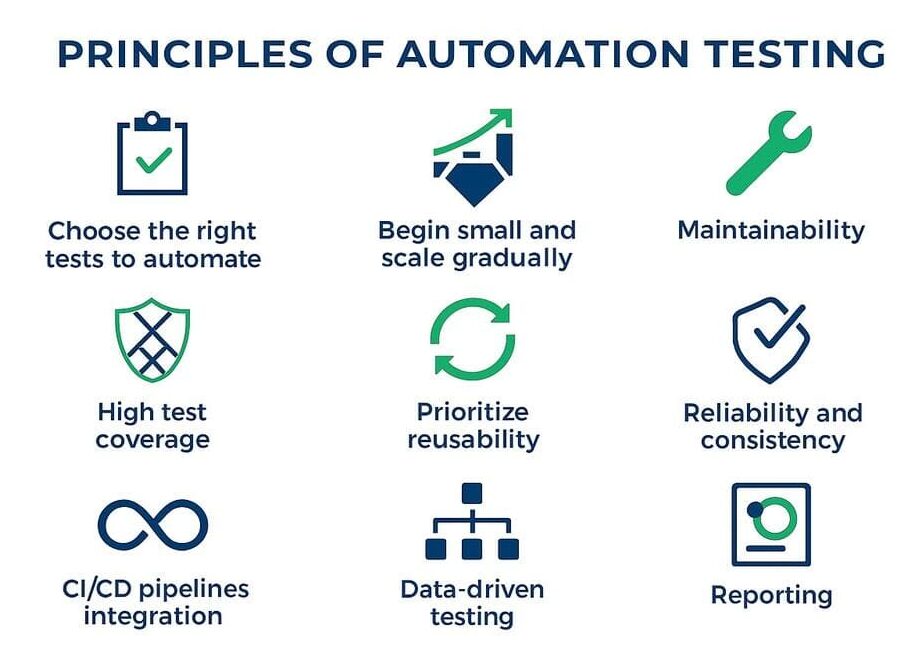Top 9 Principles of Automation Testing

Automation testing has become a keystone of software development. By incorporating automated tests into the software development pipeline, teams can save their time to ensure high-quality applications, and encounter the demands of fast-paced Agile and DevOps cycles. However, successful automation testing requires a clear understanding of basic principles of testing. So, let us explore the fundamental principles of automation testing and how these principles deliver effective test automation.
Core Principles of Automation Testing
Test automation principles guide the creation of efficient, reliable, and maintainable automated testing practices. The principles emphasize aspects like the SOLID principles for software design, alongside strategic considerations like selecting the correct tests for automation. The automation testing core principles are designed to maximize the return on investment (ROI) in test automation. Let us look into these principles:

1. Choose the right tests to automate
Automation testing is to find the right test cases for automation. Not all test cases are suitable for test automation, as some may be too complex or infrequent to justify the effort and cost. The ideal test cases for test automation are those that are:
- Tests that need to be run frequently.
- Tests for functionalities that aren’t often likely to change.
- Time-intensive tests.
By automating repetitive and time-consuming tests, your team can decrease manual effort and focus on more complex testing scenarios.
2. Begin small and scale gradually
Automation testing requires a progressive approach. Starting with a few key test cases allows testers to refine their processes, understand tool capabilities, and solve any issues earlier. Once a stable framework is established, teams can gradually add on more tests and scale up as needed.
This principle prevents your team from being overwhelmed by a large set of automated tests and allows them to focus on constructing a solid base.
3. Maintainability
Test automation should be maintainable, which means test scripts should be easy to update as application features get added. Test maintenance becomes tedious if complex scripts or has no clear structure. Following coding standards, creating modular scripts, and using reusable components contribute to a maintainable test suite. Test automation platforms like ACCELQ promote maintainability by offering no-code automation testing, where testers can create test cases without extensive programming. It simplifies updates, as testers can rapidly change tests without diving into code, ensuring a maintainable process.
4. High test coverage
Test coverage is a key metric in automation testing. A well-designed automation suite can cover as many test scenarios as possible, from core functionality to edge cases. By achieving increased test coverage, Agile/Scrum team members can raise the likelihood of detecting issues before they reach production. While high test coverage is valuable, it’s also important to avoid redundant tests. ACCELQ Unified helps to balance test coverage and redundancy by providing reports that allow teams to focus on high-priority tests and avoid over-testing.
5. Prioritize reusability
Reusability is another core principle of automation testing. Automated test scripts are written in a way that allows you to reuse them across different test scenarios. You can save more time and resources, as reusable components can be quickly adapted for various tests.
6. Reliability and consistency
A good test automation suite should yield reliable and consistent results. Unreliable test scripts can lead to false positives or negatives, undermining the testing process’s credibility. To ensure the reliability of tests, include developing stable, structured test scripts with no dependencies that will not change unexpectedly. ACCELQ aids this by supporting cross-browser testing to ensure that automated tests deliver consistent results across different environments. It will be invaluable for teams aiming to provide a seamless user experience on diverse devices.
7. CI/CD pipelines integration
In Agile and DevOps environments, automation testing is integrated into CI/CD pipelines. This integration allows tests to be triggered automatically upon code changes, providing immediate feedback on code quality and reducing bugs in production.
8. Data-driven testing
Data-driven testing is a principle that involves using many data sets to validate application behavior. This principle improves test coverage by testing how the application handles various inputs and scenarios.
9. Reporting
Automation testing should provide reports on test performance, pass/fail test rates, and defect trends. Reporting allows your team to track their testing progress, find areas to improve, and make data-driven decisions. ACCELQ Manual offers a next-gen test management for Agile teams by providing dynamic reports with perspectives to easily slice and dice, enabling QA engineers to monitor trends and make informed decisions. It helps to optimize test automation efforts and enhance overall software application quality.
Conclusion
Following the principles of automation testing is crucial in achieving a successful and sustainable automation framework. With a tool like ACCELQ, teams can easily adhere to these principles, ensuring that their automation testing efforts yield high ROI and contribute to high-quality software. By focusing on the right tests, starting small, prioritizing reusability, and integrating with CI/CD pipelines, teams can streamline their software testing and achieve reliable, efficient, and scalable test automation.
You Might Also Like:
 Master Python Regex Testing: Your Go-To Guide for Test Automation
Master Python Regex Testing: Your Go-To Guide for Test Automation
Master Python Regex Testing: Your Go-To Guide for Test Automation
 Boost Automation Quality: Smarter Code Reviews
Boost Automation Quality: Smarter Code Reviews
Boost Automation Quality: Smarter Code Reviews
 Role of Quality Engineering in Automation Testing
Role of Quality Engineering in Automation Testing

































